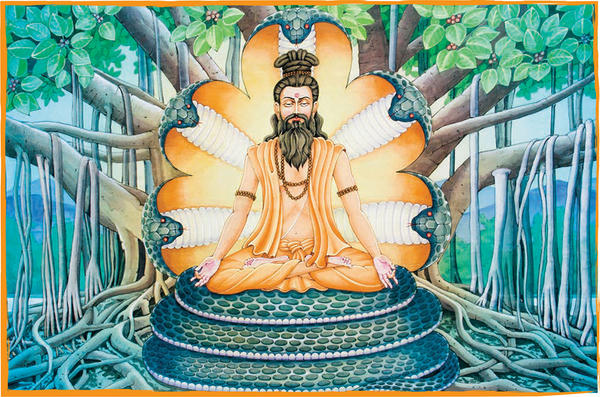44 What Is Yoga?§
Beneath a banyan tree Sage Patanjali is seated on a five-headed naga, the serpent that represents kundalini, the power in the spine. He taught the way of yoga, a path leading the seeker deep within.§
PIETER WELTEVREDE§
Yoga, meaning “union,” is Hinduism’s system of yoking our individual consciousness with transcendent or divine consciousness. Yoga was described by Sage Patanjali in his Yoga Sutras over 2,000 years ago as a system of meditation with eight limbs or stages. Hence it is known as ashtanga (eightfold) yoga. It is also known as raja yoga. Patanjali defined it as “the restraint of mental activities.” Stages one and two are yama and niyama. These define the spiritual lifestyle we need for success in meditation. The third limb is asana, meaning “seat” or “posture,” learning to sit comfortably for long periods without moving. This is achieved through hatha yoga, the postures of which balance the energies of mind and body, promoting health and serenity. The fourth stage is pranayama, regulated breathing. This is the science of controlling prana (subtle energy) through breathing techniques. Stage five is pratyahara, withdrawing awareness from the senses, emotions and thought. Like a tortoise who withdraws its head and legs into its shell for protection, the yogi withdraws his awareness from the outside world and discovers the infinite world within. The sixth stage is dharana, concentration, focusing the mind on a single object or line of thought, not allowing it to wander. Stage seven is dhyana, true meditation. Gurudeva described it as “a quiet, alert, powerfully concentrated state wherein new knowledge and insight pour into the field of consciousness.” A good meditation teaches us something new about ourselves or the world. The eighth and final stage is samadhi. This is the goal of yoga, a state in which the meditator and the object of meditation are one. Over time, specialized forms of yoga have been developed. For example, kriya yoga focuses on breath control, mantra and mudra; karma yoga transforms work into worship; bhakti yoga is union through devotion; and in some forms of hatha yoga, bodily perfection is the goal.§
GURUDEVA: If you just sit without moving, and breathe,…awareness is loosened from limited concepts and made free to move vibrantly and buoyantly into the inner depths where peace and bliss remain undisturbed for centuries.§

